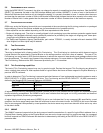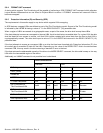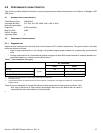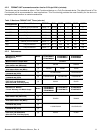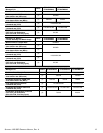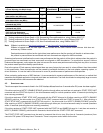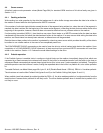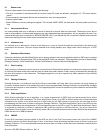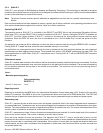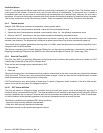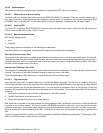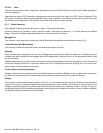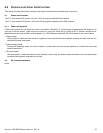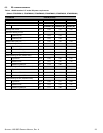SEAGATE 1200 SSD PRODUCT MANUAL, REV. A 16
5.1 ERROR RATES
The error rates stated in this manual assume the following:
• The drive is operated in accordance with this manual using DC power as defined in paragraph 6.3, "DC power require-
ments."
• Errors caused by host system failures are excluded from error rate computations.
• Assume random data.
• Default OEM error recovery settings are applied. This includes AWRE, ARRE, full read retries, full write retries and full retry
time.
5.1.1 Unrecoverable Errors
An unrecoverable data error is defined as a failure of the drive to recover data from the media. These errors occur due to
read or write problems. Unrecoverable data errors are only detected during read operations, but not caused by the read. If an
unrecoverable data error is detected, a MEDIUM ERROR (03h) in the Sense Key will be reported. Multiple unrecoverable
data errors resulting from the same cause are treated as 1 error.
5.1.2 Interface errors
An interface error is defined as a failure of the receiver on a port to recover the data as transmitted by the device port
connected to the receiver. The error may be detected as a running disparity error, illegal code, loss of word sync, or CRC
error.
5.2 ENDURANCE MANAGEMENT
Customer satisfaction with Solid State Drives can be directly related to the internal algorithms which an SSD uses to manage
the limited number of Program-Erase (PE) cycles that NAND Flash can withstand. These algorithms consist of Wearleveling,
Garbage Collection, Write Amplification, Unmap, Data Retention, Lifetime Endurance Management.
5.2.1 Wear Leveling
Wear Leveling is a technique used by the drive to ensure that all Flash cells are written to or exercised as evenly as possible
to avoid any hot spots where some cells are used up faster than other locations. Wear Leveling is automatically managed by
the drive and requires no user interaction. The Seagate algorithm is tuned to operate only when needed to ensure reliable
product operation.
5.2.2 Garbage Collection
Garbage Collection is a technique used by the drive to consolidate valid user data into a common cell range freeing up
unused or obsolete locations to be erased and used for future storage needs. Garbage Collection is automatically managed
by the drive and requires no user interaction. The Seagate algorithm is tuned to operate only when needed to ensure reliable
product operation.
5.2.3 Write Amplification
While Write Amplification is not an algorithm, it is a major characteristic of SSD's that must be accounted for by all the
algorithms that the SSD implements. The Write Amplification Factor of an SSD is defined as the ratio of Host/User data
requested to be written to the actual amount of data written by the SSD internal to account for the user data and the
housekeeping activities such as Wear Leveling and Garbage Collection. The Write Amplification Factor of an SSD can also
be directly affected by the characteristics of the host data being sent to the SSD to write. The best Write Amplification Factor
is achieved for data that is written in sequential LBA's that are aligned on 4KB boundaries. The worst case Write
Amplification Factor typically occurs for randomly written LBA's of transfer sizes that are less than 4KB and that originate on
LBA's that are not on 4KB boundaries.
5.2.4 UNMAP
A new SCSI command has been added to the SSD as part of the Thin Provisioning feature set. Use of the UNMAP
command reduces the Write Amplification Factor of the drive during housekeeping tasks such as Wear Leveling and
Garbage Collection. This is accomplished because the drive does not need to retain data which has been classified by the
host as obsolete.



